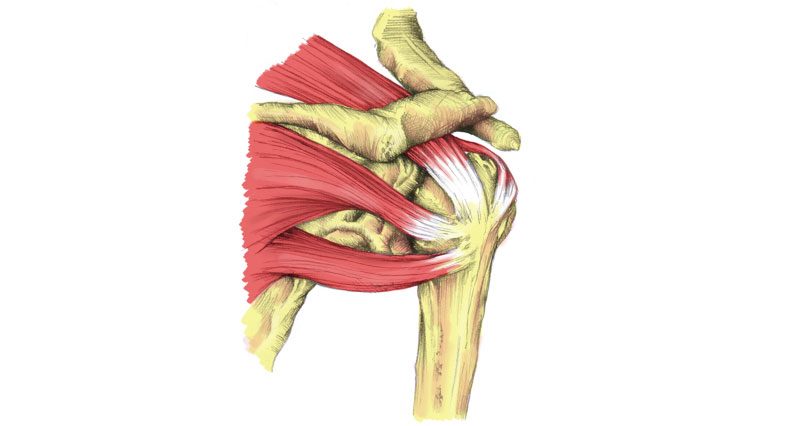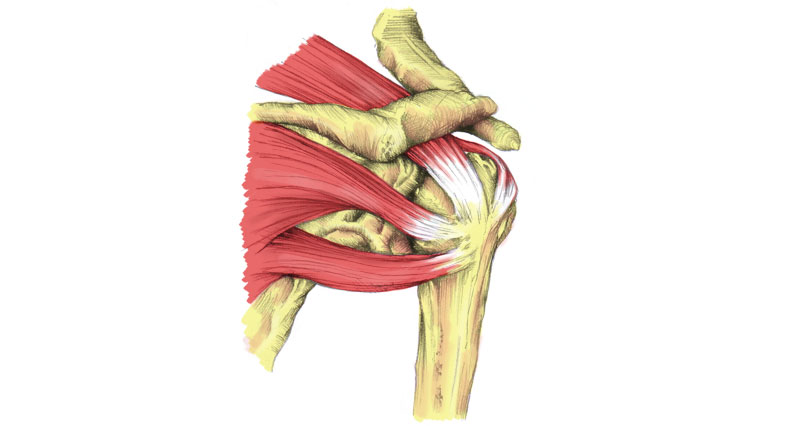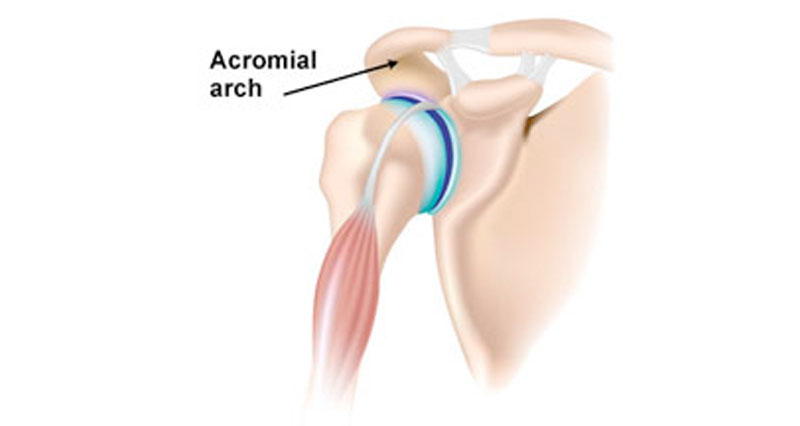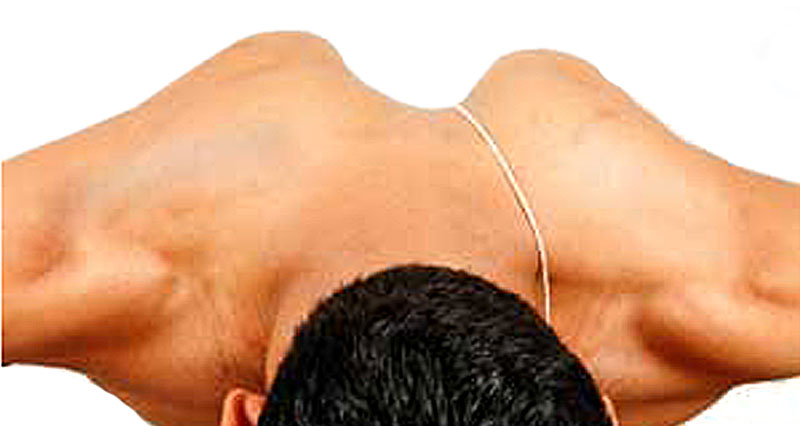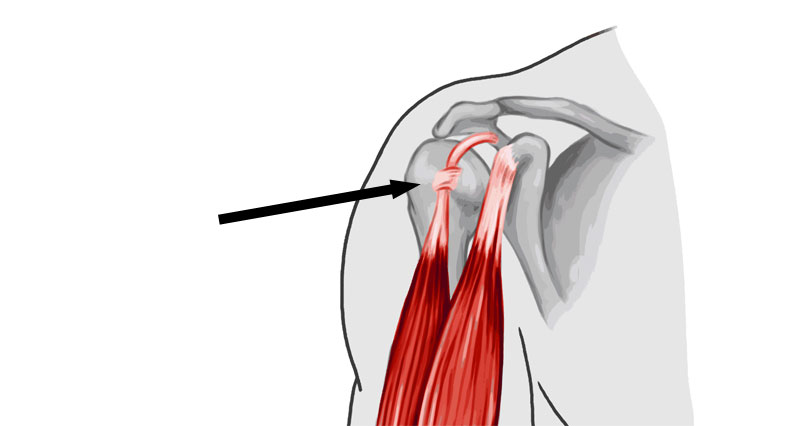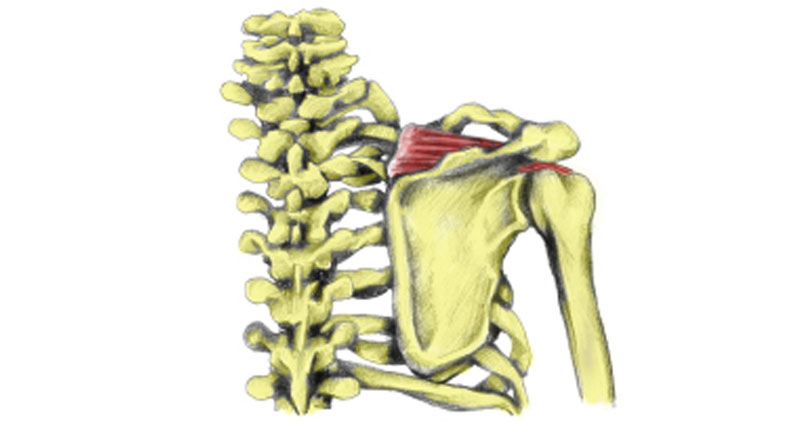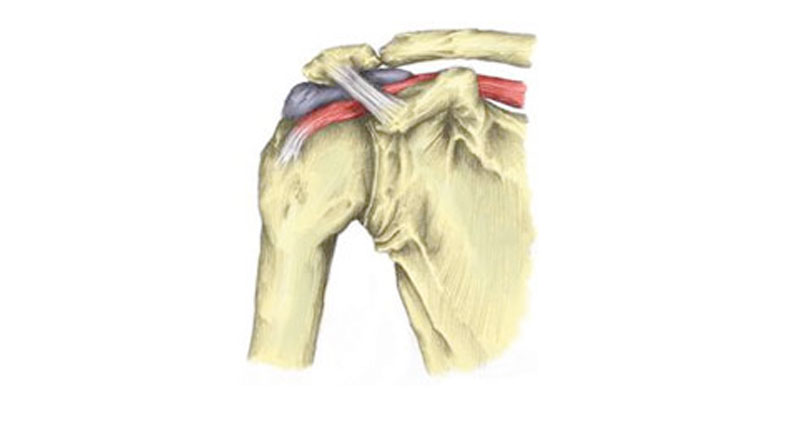Rotator cuff tendonitis (tendinopathy) is an overuse injury causing gradual onset pain in the shoulder. Here we explain the symptoms, causes, treatment, and rehabilitation of rotator cuff tendonitis
Symptoms
Often patients are unable to determine a specific point in time when their rotator cuff tendonitis injury occurred. Symptoms include:
- Gradual onset shoulder pain (days or weeks)
- Shoulder pain, even at rest which is worse at night
- Overhead movements such as in racket sports or swimming make symptoms worse
- Less pain with movements below shoulder height
- Tenderness pressing in on the painful tendon, which may feel thickened
- A creaking feeling called crepitus when moving your shoulder
An MRI scan confirms the diagnosis and identifies any tearing of the tendon.
What is rotator cuff tendonitis/tendinopathy?
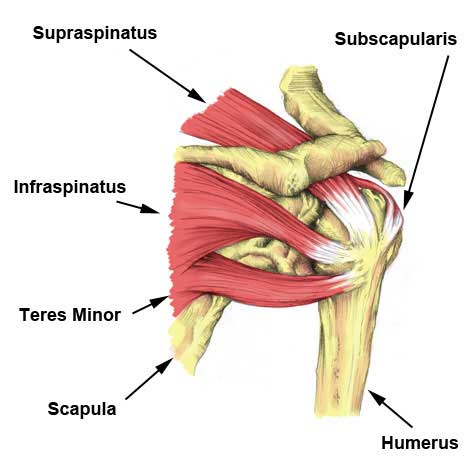
There are four main muscles which rotate the upper arm (humerus) bone. These are the Supraspinatus, Infraspinatus, Subscapularis and Teres minor. Together they are the rotator cuff muscles.
Tendonitis or tendinopathy?
Rotator cuff tendonitis (tendinopathy) is probably the most common cause of gradual onset shoulder pain and is inflammation of the tendons. Rotator cuff tendinopathy is probably a more accurate name for this injury. The ‘itis’ at the end of tendonitis refers to inflammation. The term tendinopathy includes ‘degeneration’ or wear and tear of the tendon as well.
Degeneration is more common in chronic injuries because acute inflammation cells are not usually present in long-term injuries. Other similar terms include tenosynovitis which is the degeneration of the sheath surrounding the tendon.
Causes
Overuse is the obvious cause, however, there are specific factors increasing your chance of rotator cuff injury.
Throwing sports
During throwing or overhead racket sports, huge forces slow the arm down. It is the rotator cuff muscles which do this working eccentrically, which means they contract whilst they are lengthening.
This results in even larger stresses through the rotator cuff muscle. Few throwers or those involved in racket sports focus on training these muscles. Throwers often injure the subscapularis in particular, which is stubborn to treat.
Previous injury
Patients who have had a previous rotator cuff strain are more prone to developing tendonitis, especially if they didn’t rest or rehabilitate it properly.
If part of the tendon has calcified (unwanted bone cells) then treatment is more difficult. Extracorporeal shock wave therapy along with keyhole surgery are other treatment options.
Work-related factors
Working at a desk for long periods and using a mouse or keyboard also contributes to overuse, particularly if you have poor posture.
The tiny shoulder movements required to work with a computer mouse can add up over time. A hunched and rounded shoulder posture reduces the space in the joint through which the rotator cuff tendons pass. This leads to the tendons rubbing on the underside of the acromion process at the top of the shoulder joint.
Repeated friction leads to pain and degeneration. Thickening of the tendon can make the situation even worse and may lead to impingement syndrome.
Treatment for rotator cuff tendonitis
Treatment for rotator cuff tendinopathy consists of two parts. The first priority is to treat the symptoms and reduce pain and inflammation in order to allow normal movement. The second aspect is to address the underlying causes and correct them.
Rest
Rest from activities which cause pain. The more you use the shoulder the longer it will take to heal and it may become chronic. Maintain fitness by doing other activities such as running or cycling. Avoid any shoulder exercises or weight training and in particular, avoid the activities which caused the injury in the first place.
Cold therapy
Apply ice or cold therapy every hour for 10 minutes initially reducing to 15 minutes every 3-4 hours as symptoms improve. Cryotherapy reduces pain and inflammation.
Medication
Your doctor may prescribe anti-inflammatory medication such as ibuprofen which may help in the early stages but less so long term. Do not take Ibuprofen if you have asthma, always check with your doctor if you are not sure before taking medication.
Electrotherapy
Electrotherapy treatments such as ultrasound, interferential stimulation, and laser or magnetic field therapy may be beneficial in reducing pain and inflammation.
Massage
Sports massage relaxes tight muscles in the shoulder in general. If your injury is chronic and has not responded to initial conservative treatment then your physio may use cross-friction massage to the tendon itself. This breaks down any adhesion’s between the tendon and the sheath surrounding it and reduces the injury to its acute stage to encourage correct healing.
Nitric oxide donor therapy
There is some evidence to suggest that nitrite oxide donor therapy patches applied to the shoulder can be successful. Glyceryl trinitrate patches of the correct dose (1.25mg/day) are applied to the shoulder for 24 hours at a time before being replaced.
Injections
Your doctor may inject a corticosteroid into the subacromial space of the shoulder (in the joint). This reduces pain and inflammation, allowing you to begin rehab exercises.
Correcting faults
A good therapist determines the cause of your injury, whether that be a poor technique or work-related repetitive overuse. Consequently, they identify strategies or changes to avoid the injury from recurring. In particular, exercises and taping correct poor posture and muscle imbalances.
Rotator cuff exercises
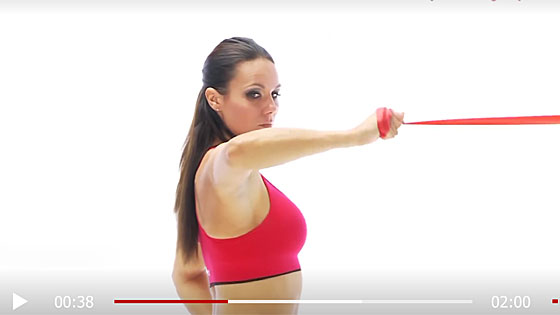
Once the inflammation has reduced and you are pain-free, rotator cuff exercises are most important. Exercises restore normal shoulder function, releasing tension in tight muscles and strengthening weaker ones.
It is usually the external rotator cuff muscles or the muscles which rotate the shoulder joint outwards which are weak, compared with the muscles which rotate the humerus inwards.
Scapulohumeral rhythm is the timing of how the shoulder blade moves with the shoulder joint. This is important for the rehabilitation of all shoulder injuries along with stretching and strengthening of the muscles which rotate the shoulder outwards (lateral rotators).
See more detail on rotator cuff exercises.
